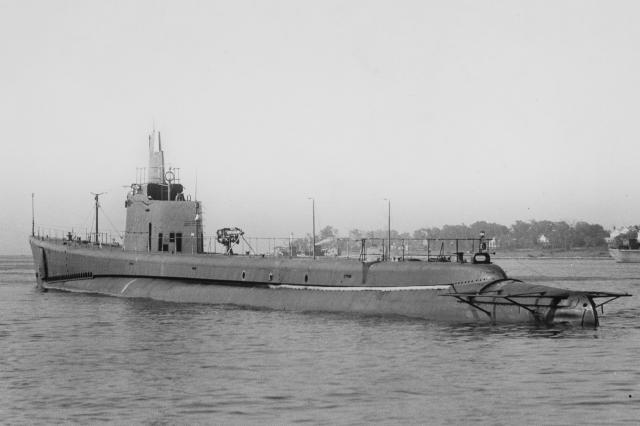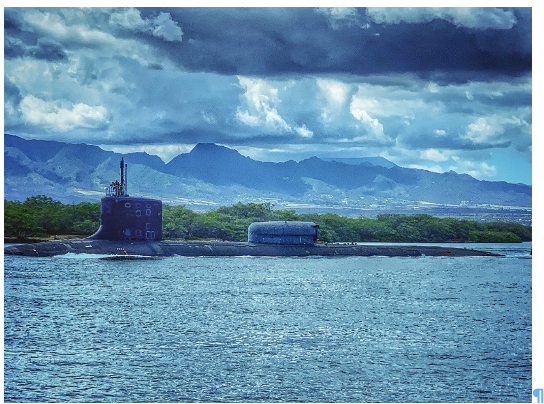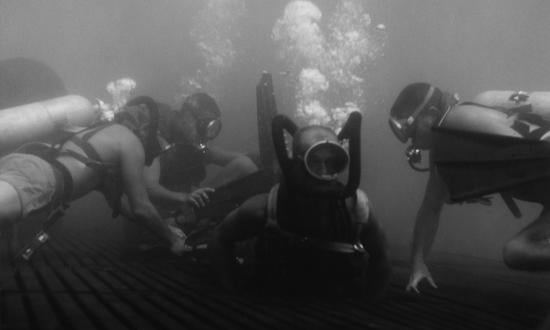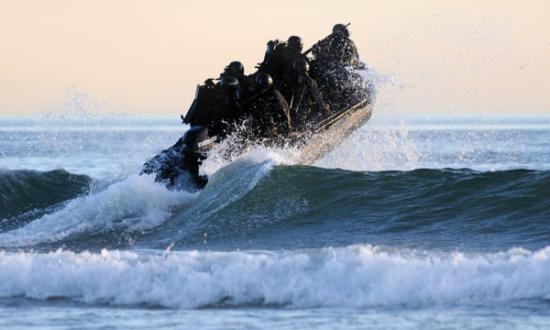Locking in and out of a submerged submarine is not something all Naval History readers (including this one) will have experienced, so let’s compare it with an everyday task. At the risk of sounding like a punchline, consider changing a light bulb. A simple task by itself, but let’s make it more applicable to Naval Special Warfare from undersea. Imagine you are changing a light bulb in pitch black darkness. A little bit harder now, but still achievable. Okay, so now replace the light bulb, in pitch black darkness, wearing a full scuba rig, underwater, upside-down, and on the back of a submarine under way and making way. Sound hard? Now you understand the feat the submarine force and Special Operations Forces (SUB SOF) team is performing today.
Learning to perform underwater operations to this level of complexity did not come easily. It came from an extremely close partnership. For decades, the partners at Naval Special Warfare Group Three and Submarine Squadron One in our Pacific SUB SOF Center of Excellence have worked together on challenging operations, underwater, making incredibly hard things seem routine.
Safe submerged diving operations are not a given, as the Navy has been reminded over the years, and everyone in the SUB SOF team knows that people’s lives are on the line when they open the dry deck shelter (DDS) hangar outer door or lockout trunk (LOT) upper hatch while submerged and put divers on deck. Note: The DDS and LOT serve as floodable chambers that allow the submarine to flood up, equalize with sea, and lock out divers, or in the case of the DDS, the SEAL delivery vehicle (SDV) mini-submarine.
Simply sending combat swimmers from a submarine to conduct an action and having them come back safely is a complex combined team skill we cannot take for granted. “This business of launching personnel out of the back of a DDS is the most dangerous thing we do on submarines,” former Submarine Squadron One Commander retired Captain Tom Kyle said. “You can’t cut corners.”
Diving from a submerged submarine is an inherently dangerous evolution. The ship is locked in depth. If the submarine goes too shallow, it could broach and send divers tumbling on a steel deck and possibly near the screw or propulsor. If it goes too deep, the divers could be injured. The divers work in tight spaces where they operate more by feel than sight, as ambient light is limited at depth, especially at night. Once they leave the vicinity of the ship, they have no voice communications with the ship, rather they (and the submarine crew) trust that they will be able to rendezvous at a specific point at a predetermined time.
Despite the inherent risk and challenges involved, submarine force and Naval Special Warfare leaders have challenged us at the SUB SOF Center of Excellence in Hawaii to look for innovative ways to expand the SUB SOF capability and sustain a ready warfighting advantage. It is important to note that the SUB SOF team takes operational security very seriously and does not discuss specific capabilities, methods, or missions. The phrase “I can neither confirm nor deny” is one heard often in the undersea community.
Our History
The SUB SOF community is rich with creative and innovative professional lessons learned throughout its history that can enhance current operations. The ability to launch SEALs from submarines is a capability that has been forged by melding the complementary cultures of the special warfare and submarine communities over the past 80 years.
In the fall of 1942, shortly after commissioning, the USS Barb (SS-20) inserted Army and Navy commandos from the Amphibious Scouts and Raiders to survey potential landing beaches and lead assault forces to those beaches during Operation Torch, the Allied invasion of North Africa. During Torch, the commandos guided two destroyers into position to enable naval gunfire support against shore-based gun positions. Today, this may seem routine, but it was anything but in 1942.
The Barb kept up the tradition after transferring to the Pacific in 1943 during operations under Commanding Officer and Medal of Honor recipient Eugene Fluckey. During a reconnaissance operation off Hokkaido during Barb’s 12th patrol, Fluckey spotted a train and remarked that he would like to “blow up” that train. One of his sailors, an electrician who worked for the railroads before the war, had the idea to rig a switch that shut under the weight of the train. Fluckey loved the idea and sent eight personnel ashore in two rubber craft with their makeshift switch and the ship’s scuttling charge, setting the trap. Later that night, they saw the train complete the circuit, and the Barb’s crew added a train to their battle flag.1
In the years following World War II, the submarines and SOF continued their partnership. The USS Perch (APSS-313), a World War II veteran, was converted to an “amphibious transport” submarine for the undersea demolition teams (UDT) at Mare Island in the 1950s. The Perch installed a pressurized landing vehicle, tracked hangar, a predecessor to today’s DDS. During the Vietnam War, in 1964, the Perch launched UDT personnel on Vietnam’s coast during Operation Deck House IV for pre-invasion beach reconnaissance.2
In 1968, the USS Grayback (SSG-574), a former Squadron One Regulus missile submarine, completed conversion overhaul to reconfigure the Regulus hangars in the bow into diving chambers. Similar to the Perch, the Grayback conducted submerged special operations during the Vietnam War. Tragically, in 1982, a combination of design problems and poor material condition in the lockout chamber led to the loss of three divers and two SEALs. This accident led to a reassessment of diver safety in the design of manned systems and the standup of the Deep Submergence System–Scope of Certification program, a quality-assurance system designed to ensure diver safety.
(U.S. Naval Institute Photo Archive)
In 1982, the naval special warfare (NSW) community commissioned its first DDS, a large diving module designed to be “bolted on” to a host submarine, eventually building a total of six. DDS expanded the number of submarines that could participate in SUB SOF to any that underwent a “fit-up” overhaul.
After the Grayback, Commander, Submarine Force U.S. Pacific Fleet consolidated Pacific SUB SOF capability at Submarine Squadron One in Pearl Harbor. Starting in the early 1980s, the Hawaii-based Sturgeon-class submarines the USS William H. Bates (SSN-680), Tunny (SSN-682), and Cavalla (SSN-684) installed DDS. The Pacific Submarine Force and NSW had agreed to “cross fit” all DDS with the three Sturgeon-class boats. Although the plan was for Newport News Shipyard (NNSY) to be the caretaker for all DDS, the Pearl Harbor team did the cross fits themselves between the Submarine Base Intermediate Maintenance Activity, SEAL Delivery Vehicle Team One (SDVT-1), and Supervisor of Shipbuilding at NNSY. The collaboration between the Pacific Submarine Force and NSW in Hawaii resulted in high skill and proficiency in DDS installs, conducting some in as little as two days.3
Sturgeon-based SUB SOF teammates gained valued experience through a number of certifications and exercises. While the Sturgeon class had suitable depth-keeping characteristics, they were small and could not sustain an embarked SOF unit for more than a few weeks.
Captain Kyle recalled his time embarked on board the Tunny for an inspection in the mid-1990s. With personnel from the ship’s company, the embarked SOF unit from SDVT-1, and inspectors from the submarine force and NSW, there were more than 200 personnel on board. With that many people under way, the galley was the limiting factor. The cooks were preparing food almost nonstop, making galley cleanliness a concern. This problem, among others, pointed to the need for a purpose-built SUB SOF boat.
Even so, the Sturgeon-class boats gained experience throughout the 1980s and ’90s, participating in SUB SOF training and exercises in waters off Hawaii, Guam, and with foreign allies and partners, often installing and removing DDS in between deployments and sometimes during deployment. During this time, Squadron One boats improved both in operations and material management of the DDS and SOF-support systems.
During this period, the DDS-capable boats in Squadron One focused on forging formality and professionalism into their operations with the SDV and DDS platoons of SDVT-1 and SEAL Delivery Vehicle Team Two. Captain Bill Hicks, commanding officer of the William H. Bates in the early 1990s, recalled that commanding officers of the Squadron One DDS-capable boats would share lessons learned from their experiences, allowing one boat to build on the experiences of another, all the while enabling more and more challenging operations.
Hicks emphasized the risk during DDS operations the Squadron One Commanding Officers had to navigate. “There was never a single second that I wasn’t in the Control Room when the outer hangar door was open. Keeping [depth at] +/- one foot at one knot is challenging, and it’s the lives of divers and SEALs on deck which is at risk,” Hicks shared.
As the Trident class replaced the original 41 fleet ballistic-missile submarines, four of the older SSBNs had their missile tubes filled with cement and were converted to SSNs, or “slow attacks.” One of those, the USS Sam Houston (SSN-609), was assigned as a SOF boat in Squadron One, conducting DDS operations such as mass swimmer lockout during the late 1980s.
Captain Howard Reese, commanding officer of the Kamehameha from 1996 to 1999, described the boat’s purpose as creating, then subsequently demonstrating, the capabilities of SUB SOF on a large host submarine.4 These efforts would pave the way for the conversion of the first four Trident submarines to SSGNs, a hybrid SUB SOF and Tomahawk strike platform, when they could no longer serve as SSBNs under the Strategic Arms Reduction Treaty.
Reese worked with his counterpart at SDVT-1 to focus the ship’s crew and SDV/DDS platoon’s divers and SEALs on professional operations, namely compliance with written procedures, two-party valve checks on DDS support systems, and formal face-to-face communications. From this foundation, the combined Kamehameha SUB SOF team gained proficiency and a high level of knowledge of their operating procedures. Recognizing the material management challenge to maintain the DDS support systems, Reese also created a “SOF Division,” assigning an auxiliary mechanic chief petty officer to manage maintenance and repair of the DDS-support systems, a practice that continues today on SOF-capable boats.
Over the years, the Kamehameha (or Kam, as she was lovingly known) performed SUB SOF exercises near Hawaii and as far away as Guam, the Republic of Korea, Australia, and Jordan. The realistic SDV launch and recovery exercises in complex environments with high fishing and merchant activity challenged the team but led to improvements in the SUB SOF capability. Reese’s biggest concern during these operations was the ability to rendezvous with the SDV, hours after it had launched from the DDS, and Kam and the embarked task units developed some innovative means to guide the submarine to the SEALs in the water, and vice versa. We still use some of these tactics today!
During operations, Kam and the SEALs drilled and redrilled on casualties such as SDV battery fire and injured diver and practiced maintaining ship control, even in elevated sea states. “The worst thing that could happen during operations was a broach with the DDS hangar door open,” Reese shared, which can cause the seas to rush in and out, creating a “washing machine effect.” This risks material damage inside the DDS in the best case, and in the worst case personnel injury or death to the SEALs and divers in the shelter. Kam also developed and practiced a modified “emergency deep” maneuver to dive the submarine to a safe depth with divers on deck.
Captain (ret.) Kyle shared the challenges the SUB SOF community had early on in getting commanders to consider the capability as viable for contingency or planning. Kamehameha participated in exercises such as Foal Eagle with the ROK and demonstrated the utility of SUB SOF, but the community had difficulty communicating a real-world need, which meant that Task Force commanders and planners did not consider this strategic capability when crafting plans. Kamehameha participated in a joint hostage rescue exercise in the late 1990s in Hawaii, with the Commander of Special Operations Forces Pacific (SOCPAC) in overall command. The hostages were held on the Pacific Missile Range Facility on Kauai, and the SOCPAC planners developed a plan to fly Army SOF a few miles inland from the hostages and route them overland for the rescue. Kyle asked the SOCPAC commander why he didn’t use Kamehameha and the SEALs, as the hostages were held right on the beach, hundreds of yards from the submarine. The answer was simple, he (and his planners) hadn’t thought of it.5
In the late 1990s, the Pacific submarine force prepared for the inactivation of the Sturgeon-class boats and Kam with DDS fit-up of the Los Angeles–class boats—the USS Los Angeles (SSN-688), La Jolla (SSN-701), and Buffalo (SSN-715). The Los Angeles–class boats continued to develop experience and capabilities in the Pacific in the early 2000s, Captain Erik Burian recalled.6 When fast-attack boats operate with SUB SOF, they often deploy for specific, special-purpose objectives. As commanding officer of the Los Angeles, Captain Burian deployed with DDS for interoperability training along with the embarked task unit from SDVT-1, removing the DDS in Guam midway through his WESTPAC, then continuing deployment to conduct “straight-stick” fast attack tasks and missions.
After about 2007, the SUB SOF partnership in the Pacific moved from Hawaii to Submarine Squadron Nineteen in the Pacific Northwest, where the West Coast SSGNs were homeported. The USS Ohio (SSGN-726) and Michigan (SSGN-727) have maintained the strong partnership, and SUB SOF has continued to expand in experience and capability over the past decade. With the SSGNs scheduled for decommissioning in the mid-2020s, the submarine force is starting to shift the SUB SOF focus back to SSNs homeported in Hawaii, and the partnership Naval Special Warfare Group Three and Submarine Squadron One have at the SUB SOF Center of Excellence is stronger than ever.
The USS Virginia’s (SSN-774) commissioning in 2004 ushered in a new era for SUB SOF integration. The Virginia was designed from the beginning with the “plumbing and wiring” built in to support the DDS, simplifying DDS fit-ups and giving flexibility for future decisions on SUB SOF employment. This is a major improvement over previous submarine classes that carried the DDS, as a shipyard period was required to install the piping and electrical systems to make the submarine and DDS compatible. The Virginia class was constructed with the ability to install DDS “baked in” from initial construction.
As an add-on feature, the Virginia has an integral lockout trunk, a floodable chamber that can equalize with sea pressure allowing personnel to open the outer hatch and lock out of the submarine. This technology provides the submarine with an organic capability to insert and extract SEALs and divers, potentially from any Virginia-class boat, anywhere in the world. The LOT on SUB SOF–designated Virginias also has a built-in diver treatment system.
Although not as roomy as the SSGN, the Virginia provides dedicated berthing for embarked SOF teams, with the ability to install a “berthing module” in the torpedo room, providing bunks for the embarked SEALs and divers and easing the impact of the additional personnel on board. Add all of that to the remarkable situational awareness, electronic warfare capability, maneuverability, and acoustic advantages of the Virginia class, and we have a platform tailor-made for submerged insertion and extraction of combat swimmers.
In 2009, the USS Hawaii (SSN-776), the first of the SOF-capable Virginia class in the Pacific fleet, arrived in Pearl Harbor, later joined at Squadron One by the USS North Carolina (SSN-777) and Mississippi (SSN-782). Since 2013, these three boats have operated with at SDVT-1 and moved the line of scrimmage downfield by improving the ways the force conduct DDS and LOT operations.
Where We Are Going
As the designated Virginia-class SUB SOF boats in Squadron One gain experience, they are working at Naval Special Warfare Group Three to expand SUB SOF options more widely. With the correct material readiness and personnel certifications, every Virginia LOT has the potential to insert and extract SOF. Said another way, every Virginia has an inherent SUB SOF capability. As more Virginia-class boats are delivered, submerged insertion and extraction of SOF can happen anywhere a Virginia-class can steam.
In the past, use of the SUB SOF capability required months of planning, workups, and maintenance preparations. With the Virginia-class LOT, SUB SOF has the potential to provide a responsive capability, and any deployed Virginia-class submarine will be able to conduct contingency response SUB SOF missions. Mainstreaming SUB SOF from the Virginia class will require planning, maintenance preparations, practice, and increasingly complex exercises, and the submarine force is now working on exercises to test this concept. These efforts will give combatant commanders more options, as they will shrink the time from decision to action from months to days. This line of effort will make SUB SOF truly expeditionary—a fly-away capability.
Over the past four decades, SUB SOF has advanced significantly as a community. It performs extremely challenging operations professionally and safely, ands draw on the lessons from the past and applies them to ideas for the future. This is a hard business, but it is in good hands.
1. G. E. Mathieson and D. T. Gatley, United States Naval Special Warfare: U.S. Navy SEALs, New York: St. Martin's Castle Point, 2015).
2. Mathieson and Gatley, United States Naval Special Warfare: U.S. Navy SEALs.
3. Personal interview with CAPT (ret.) Bill Hicks, 5 August 2020
4 .Personal interview with CAPT (ret.) Howard Reese, 4 August 2020.
5. Personal interview with CAPT (ret.) Tom Kyle, 5 August 2020.
6. Personal interview with CAPT (ret.) Erik Burian, 5 August 2020.












